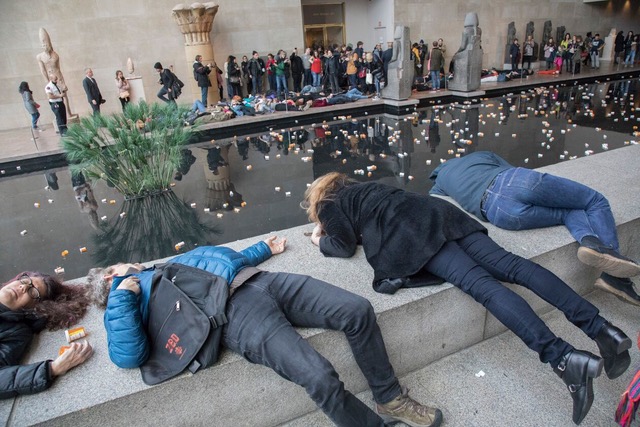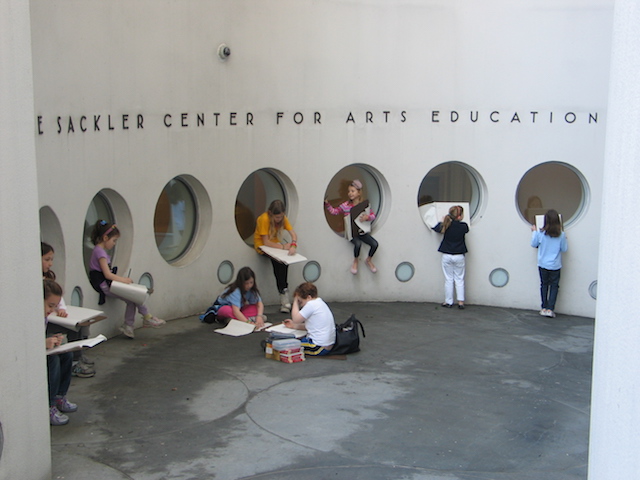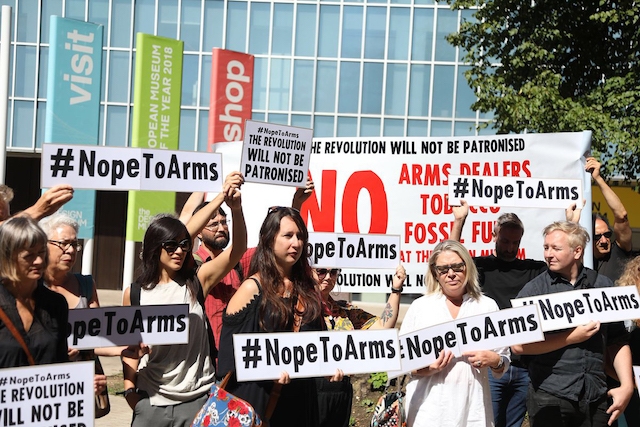In late July, artists included in Hope to Nope: Graphics and Politics 2008–18, at London’s Design Museum, published an open letter denouncing the museum’s renting of a space within the museum to Leonardo – a major aerospace and weapons manufacturer – for a private function that took place during the Farnborough Airshow, a leading UK showcase and networking event for the aerospace (and defence) business. In their letter, the signatories, calling themselves ‘Nope to Arms’, called out the museum’s apparent indifference to the ethics of fundraising in the arts sector, declaring:
By hosting an event for – and taking money from – an industry that many other arts institutions quite rightly see as beyond an ethical red line, you have made a very clear statement that you do not share these concerns and are happy to let war profiteers use your spaces if the price is right.
The artists demanded that the museum take down and return their work – about a third of those on show – by the end of the month. The works were removed.
Direct sponsorship, of course, continues to be an issue: long-running campaigns by artist-activists to get Tate to drop its sponsorship deal with big-oil company BP (which also sponsors other high-profile London cultural institutions such as the British Museum and Royal Opera House) presumably contributed to BP’s decision to end the agreement last year (though BP insisted it was only because the current sponsorship had run its term). And, in the wake of big oil, it is arms manufacturers and ‘big pharma’ that have been the object of protesters’ anger: in March, artists and musicians scheduled to take part in the UK’s Great Exhibition of the North began to withdraw in protest over the involvement of one of the event’s lead sponsors, the British defence giant BAE Systems. The ensuing bad publicity led BAE – a significant employer in the north of England – to withdraw its sponsorship. On the other side of the Atlantic, photographer Nan Goldin has led protests against the philanthropy of members of the ultrarich Sackler family, for its lucrative ownership of Purdue Pharma, the company that brought the opioid painkiller OxyContin to market. OxyContin, misrepresented by Purdue upon its introduction in 1995 and for several years subsequently, has largely contributed to the opioid epidemic in the US, which is currently killing 115 users a day by overdose.

Artists, then, are no longer prepared to tolerate their work being used as a ‘reputational whitewash’ for corporate interests with which they disagree. But in the last few years the ’ethical red line’ between the display of contemporary art and corporate patronage has moved beyond the focus on big business’s direct sponsorship of museums and shows. Increasingly, the less direct engagements between art institutions and the interests of corporations whose activities don’t mirror the opinions of increasingly activist and campaigning artists have been drawn into controversy. In December 2017, South African artist Candice Breitz took the step of changing the title of her 2016 Love Story (a multiscreen videowork about the experience of refugees, then being presented at the National Gallery of Victoria as part of its NGV Triennial), to Wilson Must Go, in protest at the NGV hiring security staff from the firm Wilson Security – a company that has overseen immigrant detention centres controversially set up by the Australian government , and whose staff faced abuse allegations from detainees. Breitz’s action picks up from the protests against the 2014 Biennale of Sydney, from which artists withdrew to remonstrate against the biennial’s sponsorship by Transfield (since renamed Broadspectrum), another major contractor hired to manage Australia’s detention centres.
Breitz’s protest and the Design Museum debacle signal that the extended economies of art institutions have now become part of the ethics of an increasingly radicalised artworld, which often goes beyond the economy of sponsorship ‘endorsement’ into making evaluations of an art institution’s commercial and institutional behaviour in terms of the ‘company it keeps’.
This poses problems for institutions. Responding to the Nope to Arms protest, the Design Museum defended its position by arguing that it was a charity with a commitment to fundraising for its programmes, and that ‘this was a private event of which there was no endorsement by the museum’. The Nope to Arms signatories poured scorn on this, replying, ‘Museums are not neutral spaces – every decision about what is displayed, how it is labelled and how it is funded is political, and reveals something about the underlying values of the institution’.
It’s clear that what is really at stake is not so much that artworld institutions defend their ‘neutrality’, but rather that they do the opposite: that they act and make choices in a partisan way – preferably along the political and ethical lines with which those whose works they exhibit agree. In one sense, this attitude – that everything is connected and that we cannot see ourselves as ‘neutral’, disinterested or independent – is a direct descendant of the institutional critique of the 1980s. If artists such as Hans Haacke conducted an often fraught interrogation of the political limits and blind spots of the institutions of art in relation to their sponsors, theirs was an attempt not merely to signal the risks of corporate involvement in the sponsorship of art but to make the broader point that the worlds of culture and capital are anyway irrevocably intertwined. Take Haacke’s seminal work MetroMobiltan (1985). Didactically ironic, it comprises three advertising banners hanging from a replica classical cornice mimicking the Metropolitan Museum of Art’s facade in New York. Two carry statements by the oil giant Mobil justifying its continued involvement in apartheid South Africa (this was 1985). The central banner appears to promote an exhibition titled Treasures of Ancient Nigeria, ‘supported by a grant from Mobil’. Behind the pomp of the banners, and their colonial aestheticisation of timeless ‘primitive’ art, is concealed a larger documentary image of a funeral procession of black South Africans. Haacke’s point is to connect Mobil’s refusal to take political action through withdrawing its services from the apartheid state to its glamorisation of the wonders of African artistic heritage, and the Met’s complicity in this. Everything, whether you like it or not, is connected, is Haacke’s message.
The moral taint is not just in big business, but the artworld’s self-hating realisation that it isn’t as radical as it would like to think. We are all implicated, we are all guilty, is the message
But what are the political and artistic implications of accepting that ‘everything is connected’? The problem of ‘endorsement’ has been at the heart of arguments over corporate sponsorship of the arts that have raged ever since the 1980s, because the sentiment on which endorsement stands is the opposition between purity and impurity. Capital is dirty, culture is pure; and yet they cannot be disentangled. As Haacke put it in a talk at the College Art Association in New York in 1990: ‘corporations know that only high-visibility, noncontroversial art events that pack in the crowds yield what they are looking for. Events with high entertainment value are best suited to the sponsor’s desire to bask in the glow of culture, at peace with the world.’ In the artworld since the 1980s, capital desires culture, and culture can do nothing to resist it.
Why does business want to bask in the ‘glow of culture’? It is not just about a cynical manipulation of public relations. Perhaps there is a more oblique, retrospective irony embedded in MetroMobiltan. Mobil’s corporate statement (published to shareholders in 1980), which Haacke’s work quotes, declares that ‘denial of supplies to the police and military force of a host country is hardly consistent with an image of responsible citizenship in that country.’ For multinational capitalism, responsible citizenship means guaranteeing smooth and profitable trade, even to oppressive regimes.
But the concept of responsible citizenship has come to preoccupy global capitalism in a different way in the years that followed. Since the 1980s, ‘corporate social responsibility’ (CSR) has become a mainstay of how big business justifies itself in the eyes of the public and government. And a major part of CSR has been philanthropy, especially cultural philanthropy.
The history of corporate sponsorship and endorsement, then, isn’t just a story of cynical corporates trying to whitewash their bad practices and lack of ethics through the sponsorship of art, preying on vulnerable cultural institutions faced with creeping privatisation. Underlying the rise of CSR is the sense of how genuinely uncertain big business has become about how to justify itself to society. This has something to do with the changing political climate since the end of the Cold War. Capitalism may have won the Cold War, but it has spent the peace increasingly confused about where it’s headed. After all, many of the problems of the world – inequality, war and ruined environment – are, by definition, now exclusively of its making. There is no one else to blame. The history of corporate sponsorship of the arts is driven, in part, by an apologetic and defensive sense that what capitalism does is reprehensible, and that business must ‘give back’.

Corporate culture also sees itself, in some obscure, contradictory but deeply felt way, to be dirty. Someone continues to pump the oil, make the arms, manage the immigration centres, make drugs. It’s perhaps why the ultrarich, especially those with wealth sourced from vast commercial conglomerates of which they happen to be the lucky beneficiaries, seek to transform that wealth into a patronage of art. It is ethical transubstantiation. It is why Elizabeth A. Sackler, another major arts philanthropist of the Sackler dynasty and founder of the Elizabeth A Sackler Center for Feminist Art at the Brooklyn Museum, felt it necessary to make clear, following Goldin’s protest, that she didn’t belong to that branch of the Sackler family – the Sacklers who had a governing interest in Purdue Pharma. Elizabeth A. Sackler wanted her name to remain untainted. But even then, the taint of connection remains. ‘She’s not off the hook,’ Goldin told TheGuardian in an interview in January.
It’s a culture of self-policing, and the policing of art institutions, according to an ethics of behaviour that turns out to be indifferent to the content of the art and the effects of its institutions
But there is a flipside to the taint. It is that many artists and institutions no longer see that what they do has any distinction or meaning beyond the hollow workings of the cultural institutions and markets that are the direct product of an amoral capitalism. This has something to do with the pessimistic sense that there is no escape from ‘the system’, that there is no ‘outside’. It’s a position frequently argued by Andrea Fraser, one of the more prominent of a generation of artists influenced by institutional critique. In her 2011 essay ‘L’1%, c’est moi’, Fraser unpicks how growing income disparities have run in parallel with the growth of the ultrarich, which has in turn fuelled the ‘enormous expansion in the past few decades of museums, biennial exhibitions, studio art and art related degree programs, art publications, art residencies and awards’. ‘How can we continue to rationalize our participation in this economy?’ Fraser asks, while concluding, ‘In the United States, it is difficult to imagine any arts organization or practice that can escape it’. There is a strong sense of self-loathing in Fraser’s account:
If our only choice is to participate in this economy or abandon the art field entirely, at least we can stop rationalizing that participation in the name of critical or political art practices or – adding insult to injury – social justice. Any claim that we represent a progressive social force while our activities are directly subsidized by the engines of inequality can only contribute to the justification of that inequality – the (not so) new legitimation function of art museums.
The moral taint, then, is not just in big business, but the artworld’s self-hating realisation that it isn’t as radical as it would like to think. Fraser’s sharp conclusion is that ‘the only “alternative” today is to recognize our participation in that economy and confront it in a direct and immediate way in all of our institutions, including museums, and galleries, and publications’.
We are all implicated, we are all guilty, is the message. But why is there ‘no alternative’ to the one Fraser prescribes, and which, on the evidence, many artists now seek to enact? The self-loathing and guilt many artists express about their ‘privilege’ suggests that many see that the art they make and the institutions that support it have little positive value; that they have no artistic, cultural and (eventually) social value in their own right – or at least not enough that it would outweigh the connections and exchanges they make with an unethical capitalism.
Yet that is the defence the Design Museum nevertheless held to – that it has the right to make a decision about how to use private fundraising to produce exhibitions that might, despite it, be of value to its audience and to the public. As the museum’s directors put it, ‘The outcome of these protests will be to censor the exhibition, curtail free speech and prevent the museum from showcasing a plurality of views’. The decision by artists to remove their work – especially when that work itself pursues political effect on its audience – reveals the paradox of maintaining one’s own refusal to be tainted by association: it might mean that your work never reaches an audience in the first place.
These are moral contradictions and political dilemmas. Making decisions about what exchanges to make, whose money to take and how to subsist depends very much on how valuable you think what you are trying to accomplish is. If artists want to show their work in untainted circumstances, they might need to examine how to produce economies and institutions that are free of the possibility of tainted associations. That would mean actively attempting self-organised, self-resourced artistic and institutional forms, and that presents the challenge of how to carve out independence within the system, as opposed to a passive withdrawal from it. Yet what is currently offered is neither: it’s a culture of self-policing, and the policing of art institutions, large and small, according to an ethics of behaviour that, since it is about denouncing the system to be absolved of responsibility for being involved in it – to avoid being tainted by it – turns out to be indifferent to the content of the art and the effects of its institutions. It is staying in the system, while loudly rejecting it. Worse still, its biggest consequence is enclavism – the self-reinforcing insistence that only one set of political perspectives, or one set of cultural attitudes, can be tolerated. It does not have to produce any good art, since that is beside the point.
Self-purification is an indulgence. It is a demonstration of one’s personal virtue. But in their obsession with demonstrating that they are free of corruption, of being tainted, many in the artworld, paradoxically, reveal that they believe what it does is worth nothing more. To turn Fraser’s desultory statement into a question: could art represent a progressive social force even if its activities are subsidised by the engines of inequality? Art was supposed to be valuable for all kinds of reasons – it was supposed to beautify, or celebrate, or inspire, or move, or expand people’s understanding of themselves and their world, and how they might act in it. Maybe it isn’t any longer. Maybe it should be.
From the September 2018 issue of ArtReview
